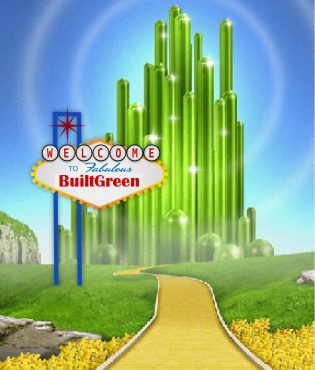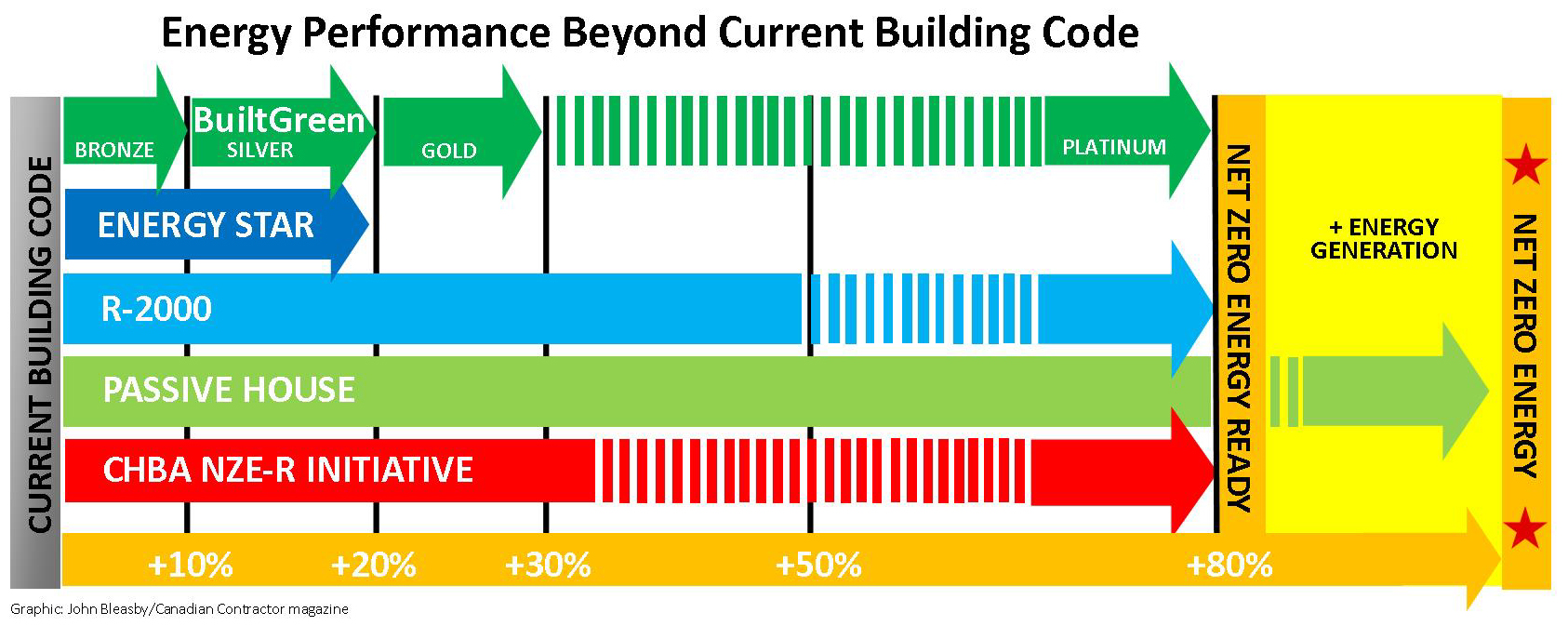
John Bleasby
Finding a path through Canada’s energy-efficiency certification programs: Part Three
Canadian ContractorIs BuiltGreen the home building certification Canada is looking for?
Canadian Contractor’s review of certifiable energy-efficiency and sustainable building programs in Canada concludes (for now) with a look at BuiltGreen, a builder-driven program that goes beyond mere energy-efficiency.
Working through the proliferation of energy efficiency programs in Canada can be frustrating for both contractors and consumers. Public perceptions are being continually influenced by media coverage concerning greenhouse gases, energy performance and carbon footprints.
In response, the industry has struggled to rally around any one design-build process that meets both the GHG commitments made by the Federal government but also works at ground level with industry. Natural Resources Canada’s (NR Can) EnerGuide system helps to some extent, but there are still a confusing number of other labels and program offerings.

BuiltGreen’s 4-tiered verification has been widely excepted in Western Canada, having certified over 34,000 homes.
The answer might be found in BuiltGreen, a certification program that has found an impressive following within the home construction and renovation industry in Western Canada. Its strategic expansion includes interests in Ontario and further east could be the best piece of good news for builders coast-to-coast who wish to stay ahead of the curve in terms of pending building code amendments.
Going beyond energy performance
The BuiltGreen program addresses energy performance and the building envelope. However, it goes much further, taking what the organization calls a “holistic” approach to reducing the environmental impact of the entire build. Modern nomenclature would suggest the term, “sustainable building.”
In fact, one might consider BuiltGreen as a successful and attainable mixture of Passive House precision with the energy conservation objectives expressed by the Energy Star and R-2000 programs developed by Natural Resources Canada (NRCan), and promoted through the CHBA under the Net Zero Energy Ready (NZEr) initiative. In fact, BuiltGreen programs are a combination of the best features of each and blends them into a certified program that builders and their customers can understand.
Here is a quick summary of how the BuiltGreen program shapes up, with reference to other existing programs.
Energy Performance:
Working within existing code, BuiltGreen offers four energy efficiency thresholds for new homes, renovations and high density projects all the way up to the so-called Net Zero Energy Ready (generally accepted as 80 per cent better than current code). In fact, a BuiltGreen home can potentially be as tight as a Passive Home. (see chart)

All the popular programs in one chart. Some programs and initiatives have the potential to go up to Net Zero Energy-Ready (NZE-r). Dotted lines indicate each program’s upper potential for energy-efficiency beyond any stated targets.
Training:
Like the R-2000 program, BuiltGreen requires training and ongoing commitment. Builders and renovators must be trained in the program’s practices, policies, and procedures prior to building their first BuiltGreen project, followed by professional development courses every two years focused on sustainable building practices. Initial courses focus on fundamentals of the program and introduce builders to the administrative and technical requirements. BuiltGreen also offers construction technology courses further develop builders’ understanding of the whole house system concept, sustainable building, and issues surrounding occupant comfort.
Energy Modelling:
Like R-2000, BuiltGreen uses the HOT2000 modelling software developed by NR Canada.

BuiltGreen certifications go from Bronze to Platinum, based on a 7-point checklist, including energy performance
Verification and Certification:
Like other certification programs available in Canada, BuiltGreen requires post-build, third party verification conducted by an NRCan-licensed energy advisor or service organization. In this way, it is similar to R-2000/Energy Star, except that it goes one better by offering a four-tiered certification, culminating with a physical label that goes alongside the EnerGuide rating label. Quality assurance procedures are also in place for the remaining sections of the checklist.
Code compliant
BuiltGreen’s program and thresholds, like the CHBA’s NZEr initiative, do not set standards — they work within the existing code and integrate with NR Canada’s EnerGuide system. In fact, to be BuiltGreen certified, the home must also have an EnerGuide rating and label.
Mortgage insurance premium savings
Like R-2000 and other select programs, BuiltGreen Homes are eligible for mortgage insurance premium discounts. In fact, all single family new homes certified through Built Green Canada are automatically eligible for a 15 per cent premium mortgage loan insurance through, CMHC, Genworth, and other providers.
Going beyond energy-efficiency with a 7-section building checklist
However, at this point, BuiltGreen goes beyond mere energy efficiency and addresses the growing public awareness of ecological conservation and carbon reduction: materials and methods; indoor air quality; ventilation; waste management; water conservation (ex. grey water recycling); and business practices. “These are represented in a checklist, which guides builders on how to build more sustainably and is used to calculate points towards certification in the program,” BuiltGreen says. “There are four levels of achievement: Bronze, Silver, Gold, and Platinum. Each level is based on compliance requirements including energy performance and overall points earned in the other sections of the checklist—with each level of certification, compliance requirements are higher.” In this way, BuiltGreen resembles LEED, a program that has found acceptance in residential apartment and commercial construction, but limited traction in smaller residential projects.
Saving money, not costing more? Really!
One of the seven checklist items within BuiltGreen’s accreditation process concerns the handling of waste material, what they call deconstruction versus demolition. “Deconstruction involves taking building materials apart while preserving elements that can be re-purposed, recycled, or donated.” It’s something relatively easy for builders to address, and can immediately contribute to improved bottom lines. That’s great news, considering most builders associate higher costs with energy-efficiency program compliance.
Built Green has been widely embraced in Western Canada
BuiltGreen has been a hugely popular with builders in Western Canada, with over 34,000 certified homes in Western Canada including multi-story residences. Casey Edge, CEO of the Victoria Residential Builders Association feels one reason for BuiltGreen’s acceptance is that it has been designed and is managed by home building industry participants. “I am always cautious about programs created by those without skin in the game,” Edge told Canadian Contractor. “In addition, some programs focus solely on energy efficiency while Built Green also promotes water conservation, recycling etc. BuiltGreen has an education component and an emphasis on proven practice, which are critical to any credible program. Simply put, BuiltGreen is preferred because it works in the real world of home building for both contractors and consumers.”

Jenifer Christenson, Built Canada CEO
Material guidance for BuiltGreen builders
BuiltGreen provides guidance to builders by offering a product catalogue of approved materials. These products, “have been approved by Built Green Canada, giving builders peace of mind and saving them time sourcing.” However, Jenifer Christenson, CEO of BuiltGreen, is quick to point out that although these specific materials contribute towards certification, their use is by no means mandatory, nor does their use guarantee points. “These are recommended products that can be used towards points on our checklist providing it’s installed correctly,” she says. “It’s intended to help the builders and to save them time.”
At the same time, listing as an approved product should not interpreted as commercial manipulation, despite the $600 listing fee. “The approval of those products applying to be listed in the catalog is done by our technical standards committee, and requires an independent study or equivalent that quantifies and verifies the environmental benefit,” explains Christenson. “They have to be approved, there’s documentation has to be submitted, and then the technical committee determines whether they will be approved.”
BuiltGreen may soon expand nation-wide
BuiltGreen may not be very familiar to builders and renovators east of the Ontario/Manitoba border. That may soon change. “We’re keenly interested in the Ontario market and currently have some projects enrolled there for certification,” says Christenson. “As well, we know our programs are unique and believe we can fill a gap in this important market. However, we are doing further research to determine the most viable communities and will proceed from there with a deliberate, targeted approach.” Christenson adds that the Maritimes are expected to be part of their expansion eastwards down the road, recognizing what she calls, “their proclivity for sustainable building.”
Did you miss Part One and Two of this series?
Part One: Passive House leads the chart of energy-efficiency programs
Part Two: NR Canada teams up with the CHBA team up to help builders navigate their way
Got feedback? Make your opinion count by using the comment section below,
or by sending an email to:
JBleasby@canadiancontractor.ca
Follow John on Instagram and on Twitter for notifications about his latest posts


Leave a Reply